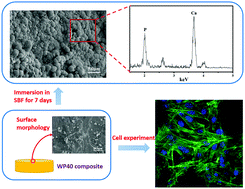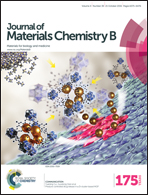Influences of mesoporous magnesium silicate on the hydrophilicity, degradability, mineralization and primary cell response to a wheat protein based biocomposite
Abstract
A novel bioactive composite based on wheat protein (WP) and mesoporous magnesium silicate (m-MS) with a high specific surface area is presented in this study for potential bone tissue regeneration. Wheat protein (WP) is a type of a biodegradable natural polymer material. The m-MS was prepared by the sol–gel technique, which was incorporated into WP to fabricate m-MS/WP composites. The increasing amount of m-MS improved the surface hydrophilicity of m-MS/WP composites. The results showed that the degradation ratio of the m-MS/WP composites increased with an increase in the m-MS content after it was soaked in a Tris–HCl solution for 12 weeks. Moreover, the m-MS/WP composites with 40 wt% m-MS content (WP40) were able to maintain a suitable pH value over a prolonged soaking time, which might be dependent on the content of the m-MS. The WP40 showed a good apatite formation ability after it was soaked in simulated body fluid (SBF) for 7 days, indicating good bioactivity. Moreover, the WP40 with cytocompatibility stimulated the attachment, proliferation and differentiation of MC3T3-E1 osteoblast cells. Briefly, the results indicated that WP40 had good bioactivity, degradability, cytocompatibility and osteogenesis and might be a new biomaterial for bone regeneration.


 Please wait while we load your content...
Please wait while we load your content...